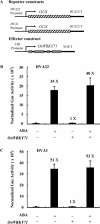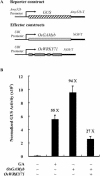A rice WRKY gene encodes a transcriptional repressor of the gibberellin signaling pathway in aleurone cells
- PMID: 15047897
- PMCID: PMC419826
- DOI: 10.1104/pp.103.034967
A rice WRKY gene encodes a transcriptional repressor of the gibberellin signaling pathway in aleurone cells
Abstract
The molecular mechanism by which GA regulates plant growth and development has been a subject of active research. Analyses of the rice (Oryza sativa) genomic sequences identified 77 WRKY genes, among which OsWRKY71 is highly expressed in aleurone cells. Transient expression of OsWRKY71 by particle bombardment specifically represses GA-induced Amy32b alpha-amylase promoter but not abscisic acid-induced HVA22 or HVA1 promoter activity in aleurone cells. Moreover, OsWRKY71 blocks the activation of the Amy32b promoter by the GA-inducible transcriptional activator OsGAMYB. Consistent with its role as a transcriptional repressor, OsWRKY71 is localized to nuclei of aleurone cells and binds specifically to functionally defined TGAC-containing W boxes of the Amy32b promoter in vitro. Mutation of the two W boxes prevents the binding of OsWRKY71 to the mutated promoter, and releases the suppression of the OsGAMYB-activated Amy32b expression by OsWRKY71, suggesting that OsWRKY71 blocks GA signaling by functionally interfering with OsGAMYB. Exogenous GA treatment decreases the steady-state mRNA level of OsWRKY71 and destabilizes the GFP:OsWRKY71 fusion protein. These findings suggest that OsWRKY71 encodes a transcriptional repressor of GA signaling in aleurone cells.
Figures









Similar articles
-
Interactions of two abscisic-acid induced WRKY genes in repressing gibberellin signaling in aleurone cells.Plant J. 2006 Apr;46(2):231-42. doi: 10.1111/j.1365-313X.2006.02694.x. Plant J. 2006. PMID: 16623886
-
A negative regulator encoded by a rice WRKY gene represses both abscisic acid and gibberellins signaling in aleurone cells.Plant Mol Biol. 2009 May;70(1-2):139-51. doi: 10.1007/s11103-009-9463-4. Epub 2009 Feb 7. Plant Mol Biol. 2009. PMID: 19199048
-
Disruption of the OsWRKY71 transcription factor gene results in early rice seed germination under normal and cold stress conditions.BMC Plant Biol. 2024 Nov 18;24(1):1090. doi: 10.1186/s12870-024-05808-9. BMC Plant Biol. 2024. PMID: 39551730 Free PMC article.
-
The genes of the Green Revolution.Trends Genet. 2003 Jan;19(1):5-9. doi: 10.1016/s0168-9525(02)00009-4. Trends Genet. 2003. PMID: 12493241 Review.
-
Functional characterization of gibberellin-regulated genes in rice using microarray system.Genomics Proteomics Bioinformatics. 2006 Aug;4(3):137-44. doi: 10.1016/S1672-0229(06)60026-0. Genomics Proteomics Bioinformatics. 2006. PMID: 17127211 Free PMC article. Review.
Cited by
-
Vitis vinifera VvWRKY13 is an ethylene biosynthesis-related transcription factor.Plant Cell Rep. 2015 Sep;34(9):1593-603. doi: 10.1007/s00299-015-1811-z. Epub 2015 May 23. Plant Cell Rep. 2015. PMID: 26001999
-
Wheat transcription factor TaWRKY70 is positively involved in high-temperature seedling plant resistance to Puccinia striiformis f. sp. tritici.Mol Plant Pathol. 2017 Jun;18(5):649-661. doi: 10.1111/mpp.12425. Epub 2016 Jul 27. Mol Plant Pathol. 2017. PMID: 27145738 Free PMC article.
-
A Group I WRKY Gene, TaWRKY133, Negatively Regulates Drought Resistance in Transgenic Plants.Int J Mol Sci. 2022 Oct 10;23(19):12026. doi: 10.3390/ijms231912026. Int J Mol Sci. 2022. PMID: 36233327 Free PMC article.
-
Annotations and functional analyses of the rice WRKY gene superfamily reveal positive and negative regulators of abscisic acid signaling in aleurone cells.Plant Physiol. 2005 Jan;137(1):176-89. doi: 10.1104/pp.104.054312. Epub 2004 Dec 23. Plant Physiol. 2005. PMID: 15618416 Free PMC article.
-
Integrated transgene and transcriptome reveal the molecular basis of MdWRKY87 positively regulate adventitious rooting in apple rootstock.Front Plant Sci. 2023 Jan 26;14:1136616. doi: 10.3389/fpls.2023.1136616. eCollection 2023. Front Plant Sci. 2023. PMID: 36778677 Free PMC article.
References
-
- Cercós M, Gómez-Cadenas A, Ho THD (1999) Hormonal regulation of a cysteine proteinase gene, EPB-1, in barley aleurone layers: cis- and trans-acting elements involved in the co-ordinated gene expression regulated by gibberellins and abscisic acid. Plant J 19: 107–118 - PubMed
-
- Diaz I, Vicente-Carbajosa J, Abraham Z, Martinez M, Isabel-La Moneda I, Carbonero P (2002) The GAMYB protein from barley interacts with the DOF transcription factor BPBF and activates endosperm-specific genes during seed development. Plant J 29: 453–464 - PubMed
Publication types
MeSH terms
Substances
Associated data
- Actions
- Actions
- Actions
- Actions
- Actions
- Actions
- Actions
- Actions
- Actions
- Actions
- Actions
- Actions
- Actions
- Actions
- Actions
- Actions
- Actions
- Actions
- Actions
- Actions
- Actions
- Actions
- Actions
- Actions
- Actions
- Actions
- Actions
- Actions
- Actions
- Actions
- Actions
- Actions
- Actions
- Actions
- Actions
- Actions
- Actions
- Actions
- Actions
- Actions
- Actions
- Actions
- Actions
- Actions
- Actions
- Actions
- Actions
- Actions
- Actions
- Actions
- Actions
- Actions
- Actions
- Actions
- Actions
- Actions
- Actions
- Actions
- Actions
- Actions
- Actions
- Actions
- Actions
- Actions
- Actions
- Actions
- Actions
- Actions
- Actions
- Actions
- Actions
- Actions
- Actions
- Actions
- Actions
- Actions
- Actions
LinkOut - more resources
Full Text Sources
Other Literature Sources
Molecular Biology Databases

